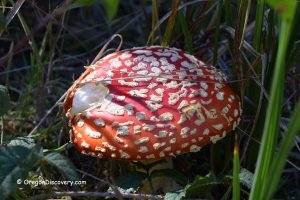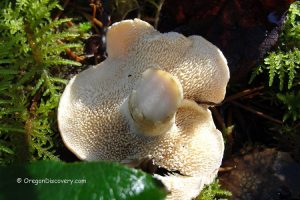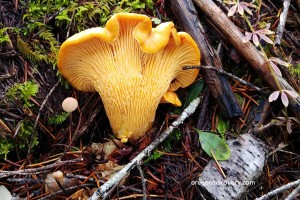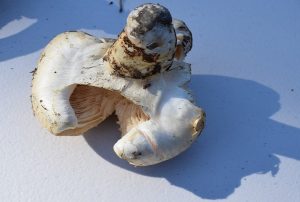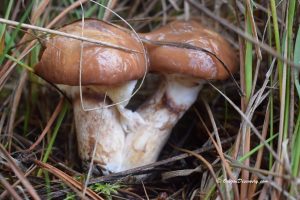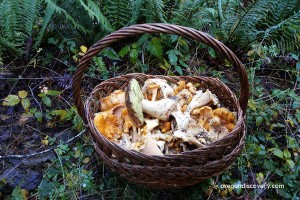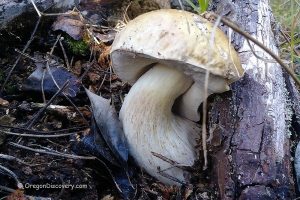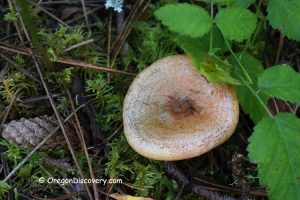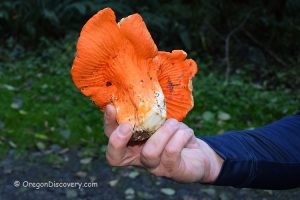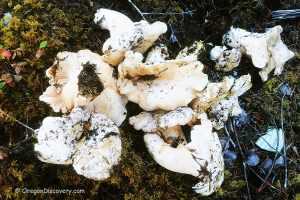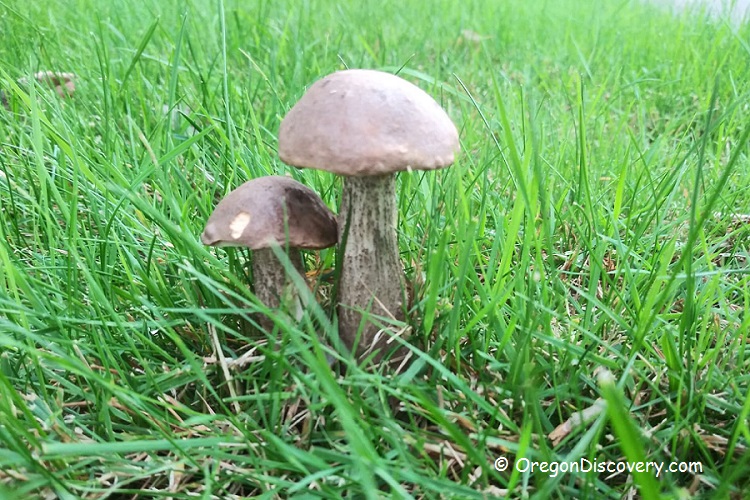
• Birch bolete associates solely with birch trees
• Use a cautious approach to eating any Leccinums
Birch Bolete (Leccinum scabrum), also known as Scaber Stalk and rough-stemmed bolete, is a medium-sized edible fungus from the Boletaceae family. The most prized in the world King Bolete belongs to the same family.
Birch bolete associates solely with birch trees.
Identification
The species are easy to identify by a "salt and pepper" stem. The broadly convex caps can be from light gray-brown to dark brown depending on the age and condition. The pores are cream to pale tan and often stain dark yellow. The stalk is club-shaped with numerous small scales, also known as scabers. It may stain blue-green at its base. The flesh is white and doesn't change in color when cut.
Where and When to Find Birch Boletes in Oregon
Because most birch trees in Oregon are planted, mushrooms are found near or under birches in lawns and parks of urban and suburban areas. Since native Birch trees in Oregon grow in the northeast part, Birch boletes in the wild are found there only. Also, these fungi are common in Washington, Montana, and Canada.
Typically, the mushroom's season lasts from late August to November, after heavy rainfalls to the first frosty nights.
Cap: Large, bun-shaped becoming nearly flat when mature. Dry when young and sticky with age, brown or gray, 1.5-4 inches (4-10 cm) wide.
Cap's Underside: Sponge-like, rounded pores, whitish to yellow-olive when mature, tubes are sunken around the stalk.
Spores & Print: Elliptical, olive-brown.
Stem: Rough with small brown or black scales, club-shaped, 3-6 inches (7-15 cm) long.
Flesh: Firm and solid, white.
Fruiting: Singly or in groups.
Habitat: Mycorrhizal with birch trees. Grows in parks and lawns under and near planted trees. In the wild - the Wallowa Mountains, Washington, Montana, and Canada.
Season: Late summer to late fall.
Look-alikes: Orange Birch Bolete (Leccinum testaceoscabrum) - edible, Aspen Bolete (Leccinum insigne) - edible, Manzanita Bolete (Leccinum manzanitae) - edible.
Birch Boletes Edibility
Birch Bolete is a great source of dietary fiber, protein, and minerals. The taste is mild, the flesh is soft and meaty. Birch Bolete and other fungi of the Leccinum family are extremely popular in Europe and have been used as a food for centuries.
In 2009, a few cases of gastrointestinal and poisoning symptoms related to Leccinums in North America have been reported.
Use a cautious approach to eating any Leccinums. It's never safe to eat a wild mushroom fresh including Birch boletes. Adopt Eastern European cooking methods for Birch boletes that include boiling them in their own broth until fully cooked.
Methods of Cooking
Methods of cooking: stir-frying, preserving, freezing, and drying. Use young and firm mushrooms. Dried mushrooms must also be thoroughly cooked. Boil mushrooms thoroughly before stir-frying, preserving, or freezing. Carefully clean and wash boletes. If needed, trim them and remove sponge layers. Slice up the fruit bodies.Birch Boletes Sautéing (1 lb /450 g)
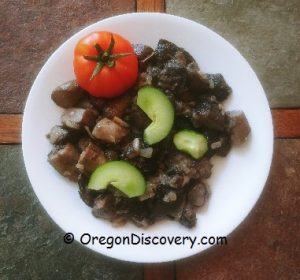
- Add water to a pan to cover all mushrooms
- Bring water to a rolling boil and cook 15-20 minutes
- Drain the mushrooms
- Heat a large skillet over medium-high heat
- Add 2 tablespoons butter or olive oil
- When the butter is melted, add mushrooms, shallot and pour 1 oz of Riesling
- Sauté them until all liquids are evaporated, stirring occasionally
- Continue sautéing for another five minutes or so, or until browned.
You May Also Enjoy
Disclaimer
This is not an official guide to wild mushroom foraging. Please, do your own research, be sure to practice with a mushroom expert before you pick up and consume any wild mushrooms. Before you start wild mushroom harvesting, learn to accurately identify poisonous mushrooms as well. All wild edible mushrooms must be thoroughly cooked. Make sure that you are not allergic to a new mushroom by trying a small amount before eating more.

